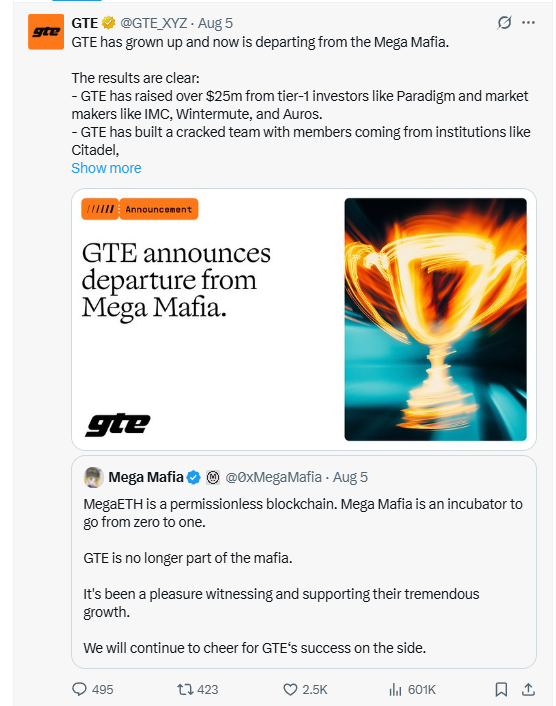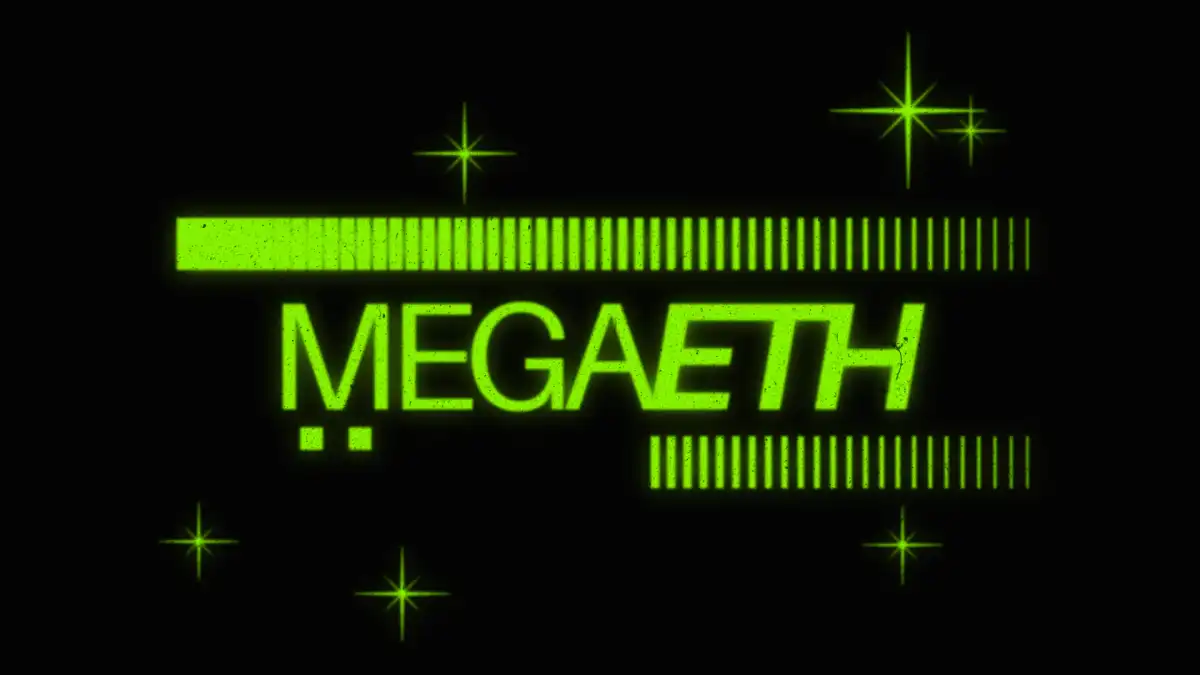Author: Frank, PANews
In the cryptocurrency community that loves to "watch the drama," there has been heated discussion over a recent "breakup" announcement. The decentralized exchange GTE (Global Token Exchange) has officially announced its separation from its underlying L2 network MegaETH and may initiate the launch of its own mainnet. This sudden change has sparked widespread discussion and speculation within the community.
Some believe this is a "team conflict" caused by ideological differences or conflicts of interest, while others have keenly pointed out that this may be a well-considered strategic bet by top venture capital firm Paradigm in the L2 space.
What lies behind this "breakup"? Is it the rupture of a partnership, or a strategic shift driven by capital? When what once seemed like a "match made in heaven" between a "killer application" and a "high-performance public chain" goes their separate ways, what will the future hold for each of them?

The Beginning of Symbiosis — The "High-Performance" Narrative of a Perfect Match
To understand this breakup, we may need to explore why GTE and MegaETH were initially so deeply bound together and the "high-performance" narrative they jointly constructed.
At its inception, GTE had a vision similar to that of Hyperliquid: to provide trading speed and experience comparable to top centralized exchanges like Binance and Coinbase while retaining the core characteristics of decentralization and non-custodial services. To achieve this goal, GTE adopted a centralized limit order book (CLOB) model commonly seen in traditional financial markets to address the pain points of high latency, high slippage, and high trading costs that are prevalent in traditional DEXs.
Supporting this ambition is a team with a prestigious background. According to official sources, its core members come from global financial and tech giants such as Citadel, Nasdaq, Google, Jump, and Palantir.
For the GTE team, achieving the aforementioned experience required building on a high-performance public chain, and most existing public chains seemed unable to support such a goal.
MegaETH is an Ethereum Layer 2 designed specifically for extreme performance. It employs Optimistic Rollup technology, aiming to push the performance of the EVM to hardware limits. MegaETH publicly claims that its network can achieve throughput of up to 100,000 TPS and sub-millisecond latency, far exceeding all mainstream blockchains at the time. To achieve this, MegaETH employs an innovative architecture that includes centralized sequencers and parallel processing, specifically serving high-frequency trading and fully on-chain gaming applications that require real-time performance.
In June 2024, its development company MegaLabs completed a $20 million seed round led by Dragonfly, with participation from industry leaders such as Ethereum founder Vitalik Buterin and Consensys founder Joseph Lubin.

In the initial promotion, the relationship between GTE and MegaETH was deeply intertwined, with GTE described as a project incubated by the MegaETH lab, specifically and exclusively built on MegaETH. GTE co-founder Enzo Coglitore publicly stated that considering GTE's extreme requirements for infrastructure, "MegaETH is the only blockchain that can provide the required performance."
This bundling strategy of "revolutionary applications require revolutionary public chains" was very successful. By the end of 2024 and the beginning of 2025, MegaETH and GTE each secured $10 million in funding. On March 21, 2025, the MegaETH public testnet officially launched, demonstrating a performance of 20,000 TPS. GTE, as the first significant application on it, attracted a large number of users and attention, validating the feasibility of MegaETH's high-performance narrative.
Behind the Split, Perhaps a Re-Bet by Paradigm
In May 2025, MegaETH's official X account was hacked, leading many users to mistakenly click on phishing links. During this process, GTE's testing was in full swing, with the official statement indicating that it achieved the goal of over 1 million users on the testnet in the past three to four months.
Moreover, GTE's excellent performance also garnered favor in the capital markets. In June 2025, Paradigm exclusively led GTE's $15 million Series A financing. This influx of funds brought GTE's total financing to over $25 million, fundamentally changing GTE's strategic position. It transformed from an incubated project reliant on MegaETH into a well-funded independent entity with full strategic autonomy. Just two months later, GTE officially announced its separation from MegaETH and its independence.
However, this breakup seems somewhat awkward, as GTE's official media account stated: "GTE has grown and is now leaving the Mega Mafia." Many believe this is a statement of betrayal. Some users on Twitter commented that this is an "application that doesn't exist, leaving a chain that doesn't exist," implying that most of the so-called users are bots.
Of course, a primary reason for this may come from GTE's recent investor—Paradigm. As a star investor in the crypto space, Paradigm has previously achieved several remarkable successes, such as Uniswap, dYdX, and Coinbase. However, in the past year or two, Paradigm's investment judgment seems to have faltered, especially during the rise and fall of Blur and Blast.
As a project Paradigm has focused on for nearly two years, Blast quickly rose with its innovative native yield model, surpassing $2.7 billion in TVL within just six months. However, its popularity did not last. Due to user dissatisfaction with the token airdrop mechanism and frequent security incidents within the ecosystem, Blast's ecosystem rapidly declined. By July 2025, its TVL plummeted 96% from its peak of $2.7 billion to about $10.5 million, and daily active users dropped from 180,000 to less than 4,000. Its token price also collapsed, falling nearly 90%.
As a major investor in Blast, Paradigm undoubtedly learned a profound lesson: deeply binding a promising application to a single L2 that has not been fully validated by the market carries significant systemic risks. The success or failure of L2 infrastructure could become a "single point of failure" for the entire investment portfolio.
Therefore, the most rational investment decision is not just to invest in GTE, but to inject enough capital to enable it to gain the ability to break free from reliance on a single infrastructure. This shifts Paradigm's bet from the uncertain question of "can L2 succeed?" to a more certain question of "can an elite application team succeed?" Additionally, after gaining independence, if GTE builds its own chain, it elevates the project's valuation from a single DAPP to the public chain level, positively impacting the project's valuation post-TGE.
However, Paradigm also has more considerations in this investment. Besides GTE, Paradigm also led a $225 million financing round for the high-performance L1 public chain Monad (a direct competitor to MegaETH). Now, as GTE cuts ties with MegaETH, it may also turn towards Monad in the future, potentially achieving a similar effect to Hyperliquid through deep binding between two hotter market projects. Through this layout, Paradigm can remain in a winning position, regardless of whether L1, L2, or self-built chain models ultimately prevail.
After the Split, Can They Each Fare Well?
Thus, the separation of GTE and MegaETH is not merely a "team conflict," but likely a rational business decision driven by capital. As for MegaETH's development, the current situation is indeed concerning. Mainstream data platforms and specialized Ethereum L2 ecosystem data platforms do not show any relevant data. Coupled with three months of silence and GTE's departure, the future development has become even more challenging. However, the MegaETH ecosystem still has several projects like Biomes, Noise, and Euphoria. Whether it can support the emergence of the next star project through the "MegaMafia" developer accelerator program will be a key focus.
For GTE, the breakup may not be the perfect choice. Within the community, there are many doubts about its actual activity level, with some users sarcastically noting that most of GTE's 1 million test users are bots. Furthermore, for GTE, whether it builds its own public chain or aligns with another public chain, it will delay the official launch of its product. By that time, it will face uncertainties in the new ecosystem and must contend with whether its product can retain enough users.
The separation of GTE and MegaETH is a microcosm of the complex relationship evolution among capital, applications, and infrastructure in the Web3 world. It marks a shift in venture capital strategy from merely supporting underlying protocols to empowering top applications. The practice of this "fat application" theory driven by capital will have a profound impact on the entire public chain landscape.
Perhaps this major separation has no absolute winners or losers; it is merely another footnote in the continuous evolution and survival of the fittest in the crypto world.
免责声明:本文章仅代表作者个人观点,不代表本平台的立场和观点。本文章仅供信息分享,不构成对任何人的任何投资建议。用户与作者之间的任何争议,与本平台无关。如网页中刊载的文章或图片涉及侵权,请提供相关的权利证明和身份证明发送邮件到support@aicoin.com,本平台相关工作人员将会进行核查。




